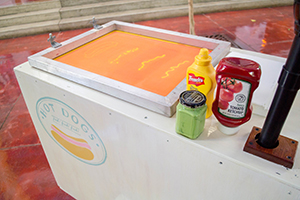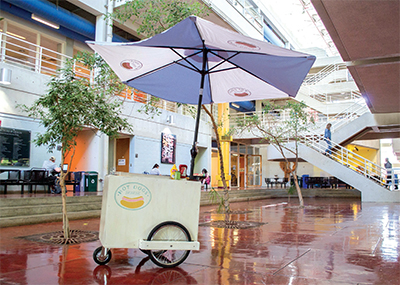A Story of Industry and Utility

Ashlee Mays, a first-year MFA student in printmaking, started a hotdog business when she moved to Knoxville. Using her hand-built cart, she sells limited edition printed images of hotdogs with the customer’s choice of live-printed condiments for one penny less than the price of a prepared hotdog within a mile of the venue.
This past winter, Mays’s piece, HOTDOG Cart, was chosen by Garth Johnson, curator of ceramics at the Arizona State University Art Museum, for a national juried exhibition, Nature and Neon, organized by Arrowmont School of Arts and Crafts in Gatlinburg, Tennessee. Johnson selected works that consider what is natural, what is unnatural, and how the intersection of both may attempt to realize its own disparate beauty.
Mays’s idea for HOTDOG Cart began when she visited UT to decide where she wanted to attend graduate school.
“I saw the man outside of the Art + Architecture Building selling his hotdogs,” she says. “Most of my work at that time was specifically interested in what physical elements shape a space. Printmaking has an industrial and utilitarian history and prints can be used as physical snapshots of information about a time and place. I felt like a hotdog cart was capable of both these things. Hotdogs have a story of industry and utility. I sell printed hotdogs as a way to exist in that history.”
Mays admits that printing in front of an audience is not her favorite thing to do. “On the other hand,” she says, “I thoroughly enjoy selling my prints in public spaces.”
She describes much of her work as being concerned with the backdrop of the everyday. “Making objects and curating experiences that directly break into that backdrop is one of my favorite things to do,” she says.
Mays was especially happy to be part of a juried exhibition at Arrowmont because, before beginning the master’s program at UT, she took courses there in fibers and material studies, pottery, and bookmaking. Her experiences at Arrowmont have been critical in shaping the way she thinks about craftsmanship. For Mays, the institution is a historical column of Appalachian craft.
“I love that this beautiful institution exists amongst the flashing LEDs of Smoky Mountain family tourism,” she says. “The intersection of traditional craft, contemporary art-making, and air-brush T-shirts is so special. I think about these intersections often and it is meaningful that these themes are apparent in my work. So many talented and lovely artists travel from all over the country to be there.”

The proximity of Arrowmont to Knoxville was important in Mays’s decision to attend UT. Even more importantly, the printmaking faculty made UT her top choice in graduate programs.
“I feel so lucky to be a part of an institution with such diverse practices,” she says. “I feel just comfortable enough in this program to take risks with my work, but uncomfortable enough to work really hard and think critically about those risks.”
Next up, Mays is creating a “Personal Finance Convenience Center,” a small vending mechanism that offers financial advice or a currency exchange for only a quarter. She also has some experiments planned for a small piece of land she purchased in Knoxville.
“The hotdog business has been going well, but I am really an entrepreneur at heart,” says Mays when asked about her plans after graduation. Before beginning her graduate studies, Mays co-founded two businesses: Twin-Peaks Press in Chicago and Pretty Good Printmaking in Gatlinburg. She plans to try out a few other business models, as well.
“But, it is good to know I can always fall back on my hotdogs,” Mays says.